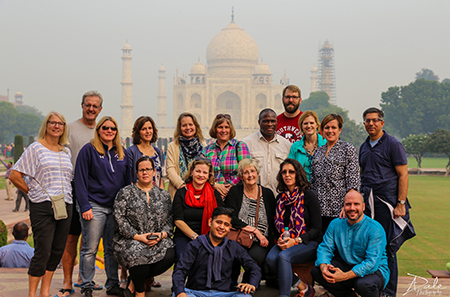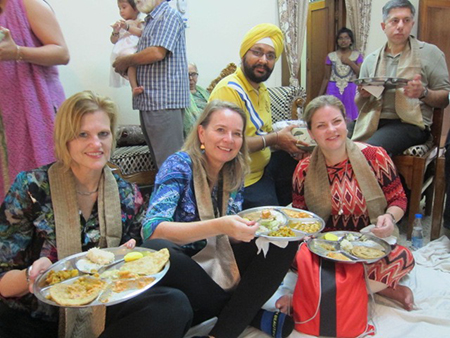CUIN Professor Laura Turchi Travels to India

Laura Turchi (fifth from the left, top row) and 18 educators pose in front of the Taj Mahal during her visit to India as a senior fellow in the Global Education Policy Fellowship Program (EPFP), November 2016.
This month Department of Curriculum & Instruction (CUIN) assistant professor, Laura Turchi traveled to Bangalore and Delhi, India, as a senior fellow in the Global Education Policy Fellowship Program (EPFP). Sponsored by the US Institute for Educational Leadership, the 18 educators who made this trip included superintendents, principals, consultants, leaders of non-profits, lobbyists (whose job translated as “Educational Evangelists” in Hindi), and higher education faculty and administrators, all from across the US. The Global EPFP program includes monthly webinars that began last summer and will continue into the new-year. The 10-day field study trip, supports first hand observations and engagement with education leaders and policymakers who are shaping India’s education reform efforts. As part of the Fulbright Senior Specialist Program, Turchi hopes to stay connected to Indian educators she met and collaborate on new efforts for teacher quality.

Laura Turchi (center) with an extended Sikh family of doctors and engineers enjoying a Diwali feasting in India, November 2016.
The India trip combined cultural and social experiences with formal presentations on India’s education policy and context. The Fellows visited historic shrines and religious temples, including the Sri Radha Krishna Temple whose Akshaya Patra initiative distributes mid-day meals to 1.5 million children in rural schools. As part of celebrating the festival of Diwali, an extended family of Sikhs invited the group into their home for a feast. The group discussed STEM education while visiting the Jawaharlal Nehru Centre for Advanced Scientific Research, Bangalore, and initiatives to improve rural teacher quality at the Azim Premji Foundation.
At the University of Delhi, the Fellows heard presentations on teacher education from faculty at Lady Shri Ram College for Women, and met with Dr. Poonam Batra, an influential member of a judicial commission that recently issued the Vision of Teacher Education in India; Quality and Regulatory Perspective report . The final day included visiting Agra and the Taj Mahal, which provided some relief from the record-shattering air pollution in Delhi. The choking air inevitably engaged the educators in environmental questions as well as education concerns, as schools were closing to reduce student exposure outside.
Turchi’s specific research interest for the trip built on her expertise in teacher education and her EDUC 3301 Introduction to Teaching course, which integrates digital tools and collaborative on-line work. Through the Global Policy Fellowship, Turchi is studying the educational implications of India’s efforts to become Digital India, and the extent to which this initiative by Prime Minister Modi could propel the Indian education system into the 21st century. The plan is to bring access and equity via internet connectedness to 1 billion people. Turchi wants to understand if the educational institutions of India might be able to leap over “1 st world” educational traditions and create new platforms for learning, with innovative roles for teachers and learners.
As excited as Turchi was to experience India, the trip certainly complicated her thinking about its schools. India is famously a land of contrasts. Turchi observed both a government school’s computer lab, which had a platoon of car batteries wired together to serve as back-up power; and a private school’s character education display board, where a student wrote an example of being kind as watching her little brother while her mother Skyped in to a business conference. Of course the US also has enormous disparities in wealth and educational opportunity. But because India has a vast population under the age of 14 (115 million – compared to about 35 million in the US), Indian education policy starts with enrollment: finding and accounting for children. Now as a result, more than 97% of Indian children have access to a school within one kilometer of their homes, no matter how isolated. The second challenge is retention, so that going to school daily is valued.
Turchi witnessed the need for new Indian systems to distribute food, aid access to health care, and provide other critical services. But, in her analysis, it is not obvious that these societal needs should be met by schools. In the age of the internet, it is worth asking what schools are for, and to worry that bureaucracy and politics have obscured the importance of innovation for learning. India’s current education reform rhetoric is critical of teacher quality because of poor student performance on national examinations (not unlike in the US). And like in the US, India is worried that its schools are not sufficiently providing aspirational opportunities for children. The challenge is to assure fundamental needs are met so that students can acquire the knowledge and skills needed for 21 st century jobs. It is possible that Digital India is the answer, but it is less clear that the education system will change to take advantage of the new connectivity.
Turchi’s India policy study is also connected to her ongoing research on teaching Shakespeare. In their co-authored book Teaching Shakespeare with Purpose: A Student-Centered Approach, Turchi and Columbian College of Arts & Sciences professor, Ayanna Thompson argue that to ensure equity in student learning, teachers need to adopt 21 st century approaches to the plays (required study in many Indian curricula too). Both the US and Indian education policy should promote schools as places where digital connectivity brings innovative learning opportunities for all students.